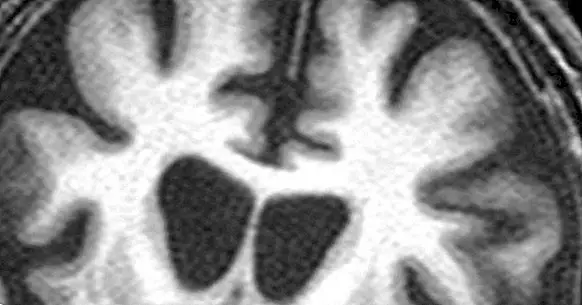Huntington's disease: causes, symptoms, phases and treatment
One of the most well-known hereditary diseases is Huntington's chorea, a degenerative and incurable disorder that causes involuntary movements and other symptoms that affect multiple areas of the person's life, progressively incapacitating it.
In this article we will describe the causes of Huntington's disease, as well as the most common symptoms and the phases through which they progress . To finish we will talk about the treatments that are usually applied to minimize the alterations as much as possible.
- Related article: "The 15 most frequent neurological disorders"
Huntington's Korea: definition and symptoms
Huntington's chorea is a hereditary degenerative disease that affects the brain and causes different physical, cognitive and emotional symptoms.
It is incurable and ends up causing the death of the person, usually after 10 to 25 years. Drowning, pneumonia and heart failure are common causes of death in Huntington's disease.
When the symptoms begin before the age of 20, the name "juvenile Huntington's disease" is used. In these cases the clinical picture is something different from the usual and the progress of the disease is faster.
The most characteristic sign of this disease is the Korea that gives its name . It is known as "chorea" a set of neurological disorders that cause involuntary and irregular contractions of the muscles of the feet and hands. Similar movements also occur on the face.
In the case of juvenile Huntington's disease the symptoms may be somewhat different. They emphasize the difficulties to learn new information, the motor clumsiness, the loss of abilities, the rigidity of the march and the appearance of alterations in the speech.
Causes of this disorder
Huntington's chorea is due to a genetic mutation that it is inherited through an autosomal dominant mechanism . This implies that the children of an affected person have a 50% chance of inheriting the gene, regardless of their biological sex.
The severity of the mutation also partially depends on the inheritance and influences the development of the symptoms. In the most severe cases the affected gene (the "huntingtin") manifests very early and severe.
This disease affects the entire brain; but nevertheless, the most important lesions occur in the basal ganglia , subcortical structures related to movement. The area known as "neo-striped", which is composed of the caudate nucleus and the putamen, is especially affected.
- Related article: "Basal ganglia: anatomy and functions"
Development of the disease
The symptoms of Huntington's disease vary depending on the specific case. However, their progress is usually grouped into three distinct phases.
The alterations worsen in psychophysiological stress conditions, as well as when the person is exposed to intense stimulation. Likewise, weight loss is common in all phases of the disease; It is important to control it since it can have very negative consequences for health.
1. Initial phase
During the first years it is possible that the disease goes unnoticed : the early signs of Huntington can be subtle, implying not remarkable deteriorations in the speed of movement, in the cognition, in the coordination or in the march, as well as the appearance of choreic movements and rigidity.
The emotional alterations are also very common already in the initial stage. In particular, irritability, emotional instability and decreased mood occur, which can reach the criteria of major depression.
2. Intermediate phase
In this phase, Huntington's disease is more visible and interferes to a greater extent in patients' lives. Chorea is particularly problematic. Difficulty speaking, walking or handling objects they also increase; Together with cognitive impairment, which is becoming significant, these symptoms hinder independence and self-care.
On the other hand, the worsening of emotional symptoms tends to damage social relationships. In large part this is due to the behavioral disinhibition derived from Huntington, which causes in some people to be aggressive or hypersexual, among other disruptive behaviors. Later the sexual desire will decrease.
Other typical symptoms of the intermediate phase are decreased pleasure (anhedonia) and alterations to reconcile or maintain sleep , which are very distressing for patients.
3. Advanced phase
The last stage of Huntington's chorea is characterized by the inability to speak and to execute voluntary movements , although the majority of people conserve the conscience of the environment. There are also difficulties to urinate and defecate. Therefore, in this period patients depend completely on their caregivers.
Although the choreic movements may be aggravated, in other cases they diminish when the disease is at a very advanced stage. The difficulties to swallow increase, being able to cause the death by drowning. In other cases, death occurs as a result of infections. As well there are many suicides in this phase .
The progress of the disease is usually faster when it appears at an early age, especially in children and adolescents, so the symptoms of the advanced stage appear earlier.
Treatment and management
At present there is no known cure for Huntington's disease, so the physical and cognitive deterioration can not be stopped . However, there are symptomatic treatments that can alleviate the discomfort and increase the independence of the affected people to a certain extent.
Dopamine blockers are used to treat abnormal behaviors typical of the disease, while for additional movements are usually prescribed drugs such as tetrabenazine and amantadine.
As the disease progresses they are introduced physical supports that facilitate or allow movement , like the handrails. Physiotherapy can also be useful to improve the control of movements, and physical exercise benefits general health, including psychological and emotional symptoms.
Difficulties in speaking and swallowing can be reduced by linguistic therapy. Likewise, special utensils are used to eat until it becomes necessary to resort to tube feeding. It is recommended that the diet be based on nutrient-rich foods and easy to chew to minimize patient problems.
- Maybe you're interested: "Parkinson's: causes, symptoms, treatment and prevention"



















